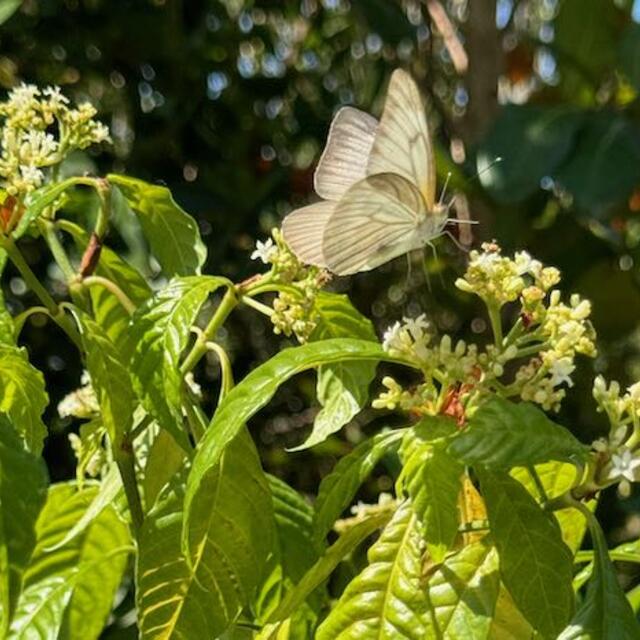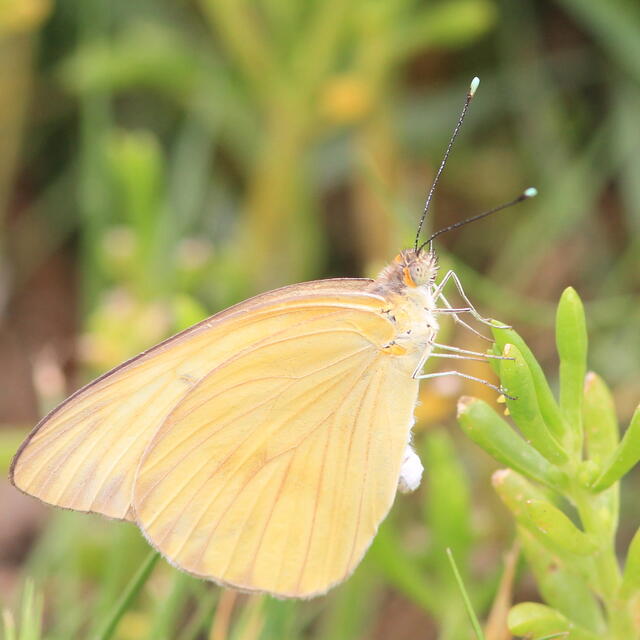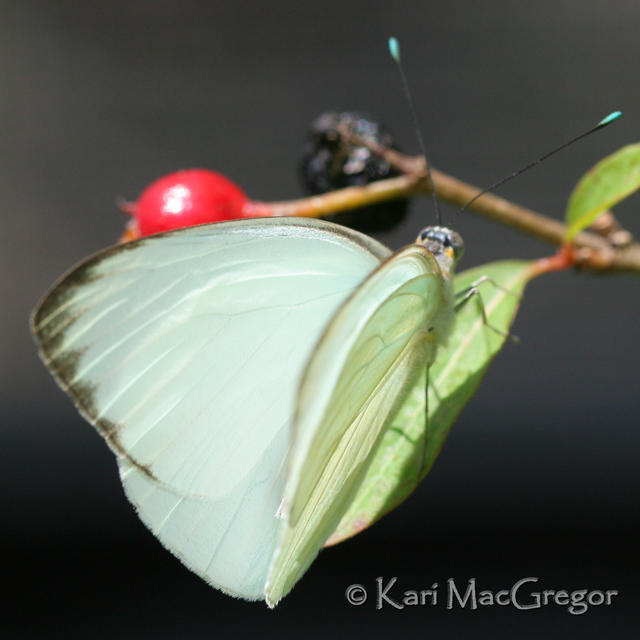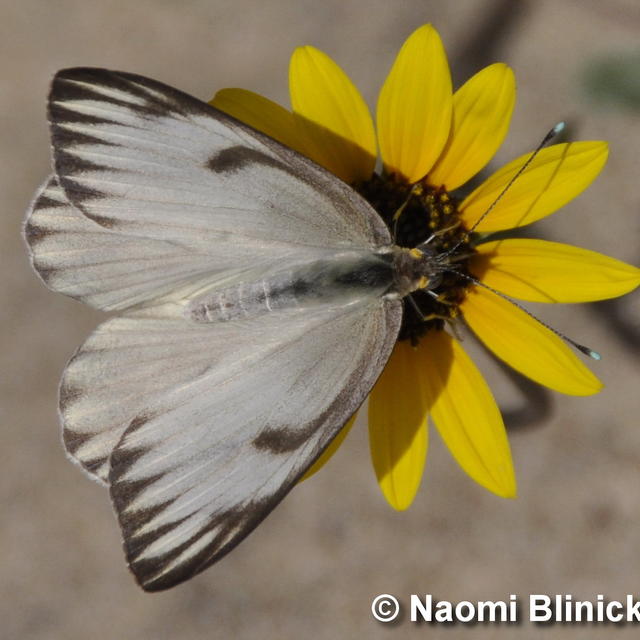Great Southern White
Ascia monuste (Linnaeus, 1764)
Family: Pieridae
Subfamily: Pierinae
Identification: Upper surface of male forewing white with black zigzag pattern on outer margin. Dry season female form resembles male with heavier black zigzag pattern and a small black spot in the wing cell. Wet-season female is darkened with black scales above and below.
Wing Span: 2 1/2 - 3 3/8 inches (6.3 - 8.6 cm).
Life History: Males patrol for females. Eggs are laid on the upper surface of host plant leaves in groups of about 20.
Flight: All year in South Texas, peninsular Florida, and along the Gulf Coast.
Caterpillar Hosts: Mustard family (Brassicaceae) plants including beach cabbage (Cakile maritima), cultivated cabbage and radish, peppergrass (Lepidium species); and plants in the caper family (Capparidaceae) including nasturtium.
Adult Food: Nectar from many species of flowers including saltwort, lantana, and verbena.
Habitat: Salt marshes, coastal dunes, open fields, and gardens.
Range: Resident of south Atlantic and Gulf coasts south through tropical America. Migratory along the Southeastern coast. Strays to Maryland, Kansas, and Colorado.
Conservation: Not usually required.
NCGR: G5 - Demonstrably secure globally, though it may be quite rare in parts of its range, especially at the periphery.
Management Needs: None noted.
BAMONA Shop
Please donate!
We depend on donations to keep Butterflies and Moths of North America freely available. We want to express our gratitude to all who showed their support by making a contribution this year. You can donate to support this project at any time.
Advertise with us!
Do you have a product or service that you think would interest BAMONA users? If you would like to advertise on this website, contact us by email, or use the contact form and select the "Advertising" category.
Verified Sightings
Displaying 1 - 24 of 570 verified sightings

Observation date: Feb 12, 2023
Submitted by: Dwaine Wagoner
Region: Texas, Nueces County, United States
Verified by: jwileyrains
Verified date: Aug 10, 2025

Observation date: Jun 01, 2025
Submitted by: Charlie Doggett
Region: Costa Rica
Verified by: Charlie Doggett
Verified date: Jun 12, 2025

Observation date: May 09, 2025
Submitted by: Charlie Doggett
Region: Costa Rica
Verified by: Charlie Doggett
Verified date: May 19, 2025

Observation date: Feb 13, 2025
Submitted by: hiker96
Region: Monroe County, Florida, United States
Verified by: John Calhoun
Verified date: Feb 22, 2025

Observation date: Feb 06, 2025
Submitted by: Paul Prappas
Region: Belize District, Belize
Verified by: Paul Prappas
Verified date: Feb 21, 2025

Observation date: Mar 15, 2017
Submitted by: Christinalea
Region: Hidalgo County, Texas, United States
Verified by: jwileyrains
Verified date: Feb 06, 2025

Observation date: Sep 18, 2021
Submitted by: Mary Scott
Region: Pima County, Arizona, United States
Verified by: John Saba
Verified date: Dec 06, 2024

Observation date: Nov 26, 2024
Submitted by: Charlie Doggett
Region: Costa Rica
Verified by: Charlie Doggett
Verified date: Dec 06, 2024

Observation date: Dec 01, 2024
Submitted by: Sapper Dan
Region: Bell County, Texas, United States
Verified by: jwileyrains
Verified date: Dec 02, 2024

Observation date: Jul 09, 2023
Submitted by: dvollmar
Region: Monroe County, Florida, United States
Verified by: John Calhoun
Verified date: Aug 12, 2024

Observation date: Jul 20, 2024
Submitted by: Charlie Doggett
Region: Costa Rica
Verified by: Charlie Doggett
Verified date: Jul 26, 2024

Observation date: Jun 18, 2024
Submitted by: Charlie Doggett
Region: Costa Rica
Verified by: Charlie Doggett
Verified date: Jun 19, 2024

Observation date: Jun 02, 2024
Submitted by: Lani57
Region: Indian River County, Florida, United States
Verified by: John Calhoun
Verified date: Jun 03, 2024

Observation date: May 27, 2024
Submitted by: Charlie Doggett
Region: Costa Rica
Verified by: Charlie Doggett
Verified date: May 27, 2024

Observation date: Apr 27, 2024
Submitted by: Sue Bocchicchio
Region: Cameron County, Texas, United States
Verified by: stomlins701
Verified date: May 18, 2024

Observation date: May 17, 2024
Submitted by: bluebird264
Region: Collier County, Florida, United States
Verified by: John Calhoun
Verified date: May 17, 2024

Observation date: May 16, 2024
Submitted by: jrmbutterfly
Region: Texas, Nueces County, United States
Verified by: jwileyrains
Verified date: May 17, 2024

Observation date: May 15, 2024
Submitted by: Diane R Halpin
Region: Marion County, Florida, United States
Verified by: John Calhoun
Verified date: May 15, 2024

Observation date: May 09, 2024
Submitted by: jrmbutterfly
Region: Texas, Nueces County, United States
Verified by: jwileyrains
Verified date: May 10, 2024

Observation date: May 03, 2024
Submitted by: Keysgirl
Region: Monroe County, Florida, United States
Verified by: John Calhoun
Verified date: May 03, 2024

Observation date: Apr 29, 2024
Submitted by: jrmbutterfly
Region: Texas, Nueces County, United States
Verified by: jwileyrains
Verified date: May 01, 2024

Observation date: Apr 29, 2024
Submitted by: jrmbutterfly
Region: Texas, Nueces County, United States
Verified by: jwileyrains
Verified date: May 01, 2024

Observation date: Apr 27, 2024
Submitted by: jrmbutterfly
Region: Texas, Nueces County, United States
Verified by: jwileyrains
Verified date: Apr 29, 2024

Observation date: Apr 12, 2024
Submitted by: jthompson6112
Region: Sarasota County, Florida, United States
Verified by: John Calhoun
Verified date: Apr 20, 2024
- 1 of 24
- next ›









